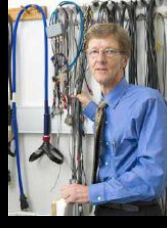
Physiology News Magazine
Physiology in Australia
For 150 years, physiology has been doing rather well for itself in Australia – maintaining international connections and winning international recognition. PN’s own emigrant, Samantha Passey, talks to an established ‘Aussie’ physiologist, Simon Gandevia, and early-career researcher, Prajni Sadananda to get a true picture of the present and future for the field.
Features
Physiology in Australia
For 150 years, physiology has been doing rather well for itself in Australia – maintaining international connections and winning international recognition. PN’s own emigrant, Samantha Passey, talks to an established ‘Aussie’ physiologist, Simon Gandevia, and early-career researcher, Prajni Sadananda to get a true picture of the present and future for the field.
Features
Samantha Passey
University of Melbourne, Australia
https://doi.org/10.36866/pn.91.25
The arrival of Professor George Halford in Melbourne aboard the Agincourt in December 1862 heralded the start of an era for physiology, and indeed medicine, within Australia. Halford had travelled on a three-month journey from England to take up a position as the first Professor of Anatomy, Physiology and Pathology at the University of Melbourne.

Since those early days, the department has gone from strength to strength and in 2012 celebrated its 150th birthday. The department was the first in Australia and so the recent celebrations commemorated not only 150 years of physiology at the University of Melbourne, but 150 years of physiology research and teaching within Australia. The event was marked with the publication of Life’s Logic written by Juliet Flesch, a book that chronicles the history and development of Australia’s first physiology department, its ups and downs, successes and occasional scandals, right up to the present day.
And ups and downs there have been. From the early founding years there are reports of difficulties, such as lack of funding, equipment and space for research and teaching activities, problems with retaining trained staff – as physiology ‘demonstrators’ were only employed on temporary contracts – and complaints about heavy administration and teaching loads leaving precious little time to devote to their research programmes. Readers may be nodding their heads at this point at the hauntingly familiar obstacles faced by academics in those early days. In some ways it seems little has changed!
Much has changed, however, and the department has grown and developed over the years to become firmly established at the forefront of physiology research and teaching in Australia, and indeed globally. Even in those early founding days, academics were attracted to Melbourne from across the globe to take up academic positions in physiology and many maintained active links with other researchers in the US and Europe. This is still a feature of physiology research in Australia today, despite the geographical distance between Australia and many other countries.
From the early founding days in Melbourne, physiology grew in Australia over the next few decades, becoming prominent in the teaching of medicine across the country and as a discipline in its own right. There have been many successes achieved by Australian physiologists, including a number of Nobel Prize awards over the years. Sir Howard Walter Florey was awarded the 1945 Nobel Prize in Physiology or Medicine along with Sir Alexander Fleming and Ernst B Chain for their work in the discovery and investigation of penicillin and its effects in infectious diseases. Later, in 1963, Sir John Carew Eccles won a Nobel Prize, along with Sir Alan Hodgkin and Sir Andrew Huxley, for their work in neurophysiology and the nature of synaptic transmission in the nervous system.
More recently, in 2009, Elizabeth Blackburn was awarded the Nobel Prize in Physiology or Medicine for her work in studying the protection of chromosomes by telomeres and the actions of telomerases. Born in Tasmania, Elizabeth Blackburn is a graduate of the University of Melbourne and has conducted her research both in the UK and in San Francisco in the USA.
Australia has developed a thriving physiology and medical research environment with numerous institutions, collaborative alliances and multidisciplinary research teams generating world leading physiology research findings. So looking to the future, what lies ahead for Australian physiology and medical research?
To find out more, I asked the internationally renowned physiologist Simon Gandevia from the NeuRA (Neuroscience Research Australia) Institute in Sydney for his thoughts on physiology in Australia.
Simon Gandevia

By way of introduction, I am a clinical neurophysiologist and a long-term NHMRC Research Fellow. My work is centred on understanding human movement and a range of motor impairments when this system fails. Over my career, I have had continuing interest in the brain’s control of breathing, particularly in spinal cord injury and respiratory disorders; the control of human movement and in particular the hand; and understanding the proprioceptive senses which are used to guide all muscle contractions and movements. All my studies are conducted on human volunteers and patients and they use a range of invasive, clinical and psychophysical tests.
What would you say are the similarities and differences between conducting research in a not-for-profit research institute like NeuRA compared to an Australian University environment?
To detail the similarities and differences between operations of a research institute and a university would take some time! A key element is the extent to which the research institute is truly independent from the university or other ‘institution’. One obvious difference is the focus on undergraduate teaching within a university, whereas the academic teaching in a research institute is focused more on post-graduate (usually doctoral) students. Funding for independent medical research institutes is quite different from that of a university! In all but the largest and oldest medical research institutes in Australia, research grants provide the foundation for employing the scientists and providing much of the recurrent costs for their work. Some research institutes can generate a large mass of researchers working in a particular area (e.g. cancer or immunology) and this may provide a good environment for driving the science. Of course, strong intellectual groupings can form within university departments and across faculties. Increasingly, Australian universities are employing cross-departmental strategies to bring like-minded researchers together. The true success of these strategies is probably not known!
What does the future hold for Australian physiology research?
If we follow the American model then there will be some convergence towards cellular and molecular physiology in departments/schools/centres, etc. It remains to be seen whether this trend offers real benefits to those within them or to their students. Some human physiology may be shifted to departments of exercise science, etc. Such a trend may have political rather than intellectual advantages. Despite the McKeon Review, funding for physiology and related medical research in Australia for the next five years or so does not look rosy. Neither the political nor the economic outlook favours a substantive investment either in tertiary funding or in medical research institute funding.
The recently published McKeon Review details the findings of a national investigation commissioned by the Australian Government to develop strategies to improve the health of Australians through research. After consultation with over 300 institutions, public meetings and private meetings with individuals and stakeholders in healthcare and medical research, a number of strategic objectives were proposed in a 10-year plan to incorporate the findings of medical research into the healthcare system. A number of aspects were addressed; of particular interest to many research academics, the report detailed the need to train and retain researchers in medical research, a streamlining of the grant application process, support for infrastructure development such as patient databases and tissue banks, and attracting philanthropic funding from international and national sources to support government funds through the main grant awarding bodies.
As part of the focus on training researchers, the McKeon Review detailed the requirements for additional support for early-career researchers and more flexibility in the assessment of research track records and career breaks. I caught up with an early career researcher, Prajni Sadananda, at the University of Melbourne to find out her perspective on the situation for younger researchers in Australia.
Prajni Sadananda

I am currently a post-doctoral research officer at the University of Melbourne, Department of Anatomy and Neuroscience. I completed my PhD at the University of New South Wales before undertaking a two-year post-doctoral position at the University of Bristol, UK, and finally returning to Australia. My research interests throughout my career have focused on the physiology and pharmacology of the urinary bladder, with particular emphasis on changes in bladder function following inflammation or injury to the central nervous system.
You have worked both in Australia and in the UK. What would you say were the main differences and similarities between the two in terms of research environments and opportunities?
The UK and Australia are very similar in their research environments. This makes it straight-forward to form collaborations between research labs in the two countries. During my time in Bristol, I met with numerous fellow Australian post-docs who were working in the UK. Similarly, here in Australia, there are a very large number of scientists who have come from, or previously worked in, the UK. Both ways, researchers are able to ‘hit the ground running’ when they make their move between the two countries, making it a smooth transition.
There are, however, some key differences that I have observed. Although communication technologies have bridged the enormous physical distance between Australia and Europe, we are still relatively isolated. During my time in Bristol, I was able to attend short conferences/workshops in Paris, Stockholm and Dublin, with minimal disruption to my work and at a very low cost. The ability to take part in such events was hugely beneficial as an early-career scientist. It boosted my confidence, fine-tuned my presentation skills, and introduced me to new scientists, new ideas and mentors. The relative isolation of Australia makes international conference travel more expensive and time consuming, and thus cannot be undertaken as frequently.
What attracted you to return to Australia to continue your research career?
After experiencing two English winters, I was keen to return to Australia to pursue my research! Australian post-docs enjoy a higher salary than in the UK and a higher standard of living (as well as a bit more sunshine!). These were major incentives for my return.
How do you find the Australian academic/research environment in terms of catering for career development for early-career scientists such as yourself? Are there funding opportunities for young scientists?
Australian early-career scientists have similar opportunities to their UK counterparts in terms of the availability of fellowships, grants, mentorship, society participation, and community engagement. Fellowships are available from government bodies as well as charity organisations and philanthropic sources. It is also entirely possible for Australian post-docs to make use of international organisations, for example, membership of The Physiological Society, which offers a range of funding opportunities to international members. There are also many Australian societies with partner societies in the UK, making conference participation less costly if you are member of one or the other. However, in general, I have found that Australian society memberships and conference participation are more expensive than in the UK.
Australian post-docs tend to have a tad more research experience than their UK counterparts. This is because of the additional honours year that we have here. In addition, the push to publish in Australia, I feel, is greater. As a PhD student, there is a huge emphasis on publishing your findings while you are completing your PhD. Indeed, many universities here now accept PhD theses in the form of publications. This means that the average Aussie post-doc tends to have a higher number of papers. The downside of this is that Australian fellowships (in keeping with that trend) are also publications-focused, making it often difficult for overseas post-docs to be competitive enough.
Physiology in Australia has certainly come a long way since George Halford stepped off the boat in 1862, developing into a vibrant research environment with a spirit of collaboration and cooperation that has resulted in notable successes along the way. With so much achieved from such small beginnings, the success of Australian physiology is testament to what can be achieved by the determined few who persist in their goals. As Simon Gandevia mentioned, changing trends in the organisation of research and teaching will likely influence the evolution of physiology in the future, and only time will tell what path the future of Australian physiology will take – so watch this space!
Read Samantha’s Member/Lab Profile on page 46 for her experiences of shipping her life and career down under.
